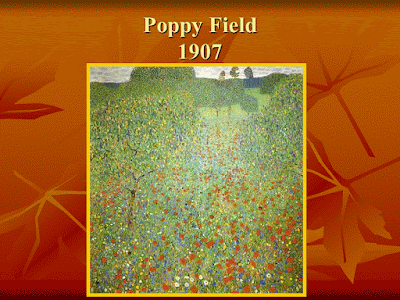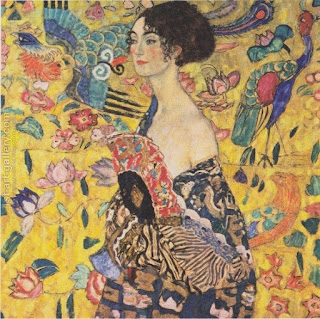Templeton Elementary School Art Literacy Program
Gustave Klimt Bio Presentation
Art vocabulary words: Symbolism
Calendar at bottom of post.
Gustave Klimt was born in Vienna Austria in 1862 to a poor family with seven children. He was very talented from a young age, and he got a scholarship to study at the Vienna School of Applied Arts and Crafts. His early work is very traditional, but over time his art became much more unusual. Klimt painted many murals and ceilings in public buildings in his early years as an artist. Here is a photo of Gustave Klimt.
The clothing is much less realistic, made up of shapes filled with fabulously detailed patterns.
Here is one of his portraits (figure 4: either Emilie Floge or Adele Block Bauer).
See how the clothes are just bands of color and pattern?
Trees are a symbol of the connection between the earth and the sky, and between life and death. If you look closely you can see eyes in the tree that are an Egyptian symbol for good health and protection.
Klimt’s backgrounds are not realistic either. (Show
figures
5 A/B and 6 A/B).
Today we will be making a portrait in the style of
Gustave Klimt, and there is gold and silver paper to use if you want to, and
lots of color as well.
Templeton Elementary School Art
Literacy Program
Gustave Klimt Mixed Media Portrait
Project
Getting
ready
Presenters, first
thing, please sign onto the Art Lit cart sign-out sheet on the wall. That way we know where the art carts are at
any time. Presenters should only be
coming in at a time they have officially signed up for. Next, please check the Art Lit cart for the
supplies you will need. The presentation
folders and the tools should all be kept on the carts. You will need to take 3 items from the
counter, unless the person before you put them on the cart. These are the supplies you will need:
On the cart:
Presentation folder and art samples
Desk protector sheets (30)
Glue sticks
Bag of pencils and pencil sharpener
6 empty blue containers for paper
bits
Scissors
6 boxes of colored markers
Take from the counter:
1 bag of mixed papers for collage
1 stack of 30 sheets of white paper
1 bag of faces (30 men and 30 women)
In the
classroom, set up the kids’ places for them.
Each student starts out with a desk protector, a sheet of white paper, a
pencil, a pair of scissors, and a glue stick.
Each table group gets a box of colored markers. (Please don’t move markers from box to
box. Each set has a good range of colors
and we want them to stay that way. If
your class has fewer than 6 table groups, just don’t use all the boxes of
markers.) You will need to portion out
all the little papers for collage into the blue containers, one for each table
group (up to 6). Try to do it evenly so
every child can have a bit of everything.
If you sit down and deal the papers out like playing cards into the
number of piles you need, you’ll get
good distribution. Next, divide up the faces from the faces bag. Give each table group about 5 men and 5 women
to choose from. Once the kids are there
you can adjust from table to table if someone wants a face they do not have at
their table. You may want to cut the
faces apart in advance so the kids don’t cut through the faces other kids need
to use.
The
Project
(Things
you might want to say to the kids are in purple.) Try to think of questions to ask the kids as you go
along. Present the artist to the kids
and show his work. Then show them the
samples of our project. Put the Klimt
samples where the kids can see them. Put
the page with two examples on the docucam so the kids can see the details. Have the kids start by writing their names
AND their teacher’s name in pencil on the back of their paper.
Introduction
Today
we are going to make a multimedia portrait in the style of Gustave Klimt. “Multimedia” means artwork that uses more
than one type of art supply, or medium, to make it with. We will be using colored markers and paper
collage. We will be making portraits of
people. We will try to make our figures’
clothes and backgrounds out of blocks of pattern and color. You can choose paper patterns to use or draw
patterns with markers, or do both.
Step 1: Choose
a face and plan the composition
To
start, choose a face you want to use for your portrait. If you like, you can draw a face yourself, or
you can use one of the faces we have printed out for you. You can cut off the extra paper around it if
you like. Place the face on your paper
and move it around; think of where you want the figure to be. Make sure to leave room for the body below
the face. Gustave Klimt liked to paint
portraits of people with their heads right up near the top of the picture. Use your pencil to lightly sketch out the
body and the background. When you’re
sure where the face will go, you can glue it down.
Step 2: Choose
colors of paper to use, and lay them out
Next
you should look at the colored and patterned papers on your table. Think about what colors you’d like to use together. You can share pieces if more than one person
wants to use a certain paper. Try to cut out your shapes along the edge of
the paper instead of in the middle, so the rest of the piece can still be used
again. There is enough silver and gold
paper for everyone to get one piece of each, so make sure you don’t take more
than your share. You can do a lot of
collage on your portrait if you want, or you can do a lot of drawing on it with
markers. It’s your choice.
It’s
a good idea to lay out your pieces of paper before you glue them down so you
can see if you like the arrangement.
Give the
kids some time for this.
Step 3: Glue the pieces down and draw with markers
When
you like what you have, glue it down.
Fill in empty parts of the picture with markers. When Klimt made portrait backgrounds,
sometimes he drew intricate flowers and plants, like the person was standing in
a garden, or in front of wallpaper.
Sometimes he painted detailed designs all over everything, like swirls,
or little interlocking bricks of color and gold. Look at the examples and think of designs you
can use in your own picture.
You
can go back and forth as you work, drawing with markers and then going back and
gluing down some more paper. Try to
fill in your paper as much as you can, but when you think it is perfect, it’s
finished. You’re the artist.
Afterwards
/ Clean up
Please make
sure to collect all the tools before you leave the room (place mats, scissors, glue
sticks, markers, blue bins and pencils), and ask kids to look for missing
items. We can’t afford to replace
things.
If it is a wet day and
you are in a portable classroom, you might tuck the stack of finished artwork
in between the plastic place mats to stay dry on the way back to the library.
Ask the kids
to pick up all the large or unused pieces of colored paper and return them to
the bag. PLEASE SAVE ALL UNUSED PAPER AND LARGE SCRAPS
FOR RE-USE. Put them into the box in the
library. Have the kids pick up and
throw away all the small bits.
Ask the kids
to put the pens back into the boxes, and if any went off their tables, check
the numbers on the pens to see they get back into the box with the same
number. If any of the pens run out,
there will be a box in the library to put them in, so I will know which ones we
need.
Take all
projects back to the Art Lit area, do not leave them in teachers’ rooms. There will be manila envelopes on the library
counter. Please write the teacher’s name
on one and put your projects inside.
Leave it in the project box. We
save them to display, then they will go home later on.
Thank you! September 2018
















